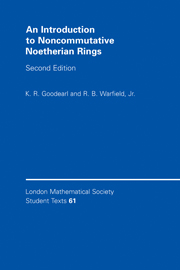Book contents
- Frontmatter
- Contents
- Introduction to the Second Edition
- Introduction to the First Edition
- Prologue
- 1 A Few Noetherian Rings
- 2 Skew Polynomial Rings
- 3 Prime Ideals
- 4 Semisimple Modules, Artinian Modules, and Torsionfree Modules
- 5 Injective Hulls
- 6 Semisimple Rings of Fractions
- 7 Modules over Semiprime Goldie Rings
- 8 Bimodules and Affiliated Prime Ideals
- 9 Fully Bounded Rings
- 10 Rings and Modules of Fractions
- 11 Artinian Quotient Rings
- 12 Links Between Prime Ideals
- 13 The Artin-Rees Property
- 14 Rings Satisfying the Second Layer Condition
- 15 Krull Dimension
- 16 Numbers of Generators of Modules
- 17 Transcendental Division Algebras
- Appendix. Some Test Problems for Noetherian Rings
- Bibliography
- Index
6 - Semisimple Rings of Fractions
Published online by Cambridge University Press: 11 November 2010
- Frontmatter
- Contents
- Introduction to the Second Edition
- Introduction to the First Edition
- Prologue
- 1 A Few Noetherian Rings
- 2 Skew Polynomial Rings
- 3 Prime Ideals
- 4 Semisimple Modules, Artinian Modules, and Torsionfree Modules
- 5 Injective Hulls
- 6 Semisimple Rings of Fractions
- 7 Modules over Semiprime Goldie Rings
- 8 Bimodules and Affiliated Prime Ideals
- 9 Fully Bounded Rings
- 10 Rings and Modules of Fractions
- 11 Artinian Quotient Rings
- 12 Links Between Prime Ideals
- 13 The Artin-Rees Property
- 14 Rings Satisfying the Second Layer Condition
- 15 Krull Dimension
- 16 Numbers of Generators of Modules
- 17 Transcendental Division Algebras
- Appendix. Some Test Problems for Noetherian Rings
- Bibliography
- Index
Summary
One of the first constructions that an undergraduate student of algebra meets is the quotient field of a commutative integral domain, constructed as a set of fractions, that is, expressions a/b subject to an obvious equivalence relation. This leads to a very useful technique in commutative ring theory, namely, to pass from an arbitrary commutative ring R to a prime factor ring R/P and then to the quotient field of R/P. In the noncommutative case, we can ask whether it is possible to pass from a domain to a division ring built from fractions. While this is not always possible, it will turn out to be the case for any noetherian domain. However, since noncommutative noetherian rings need not have any factor rings that are domains, this is rather restrictive. Instead, recalling that prime rings are the most useful noncommutative analog of domains, we look for prime rings from which simple artinian rings can be built using fractions. The main result is Goldie's Theorem, which implies in particular that any prime noetherian ring has a simple artinian ring of fractions. It turns out to be little extra work to investigate rings from which semisimple rings of fractions can be built.
Our first task is to see how a ring of fractions can be constructed, given an appropriate set X of elements in a ring R to be used as denominators.
- Type
- Chapter
- Information
- An Introduction to Noncommutative Noetherian Rings , pp. 105 - 122Publisher: Cambridge University PressPrint publication year: 2004

